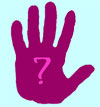While the use of tools had a practical reason for hand bias, there were other cultural influences which encouraged valuing right over left. Among these were religious and hygienic dictates.
Cultural
The right side has been overwhelmingly chosen as the good side in the practices and beliefs of most cultures. It's been theorized that man seeks symmetry and balance, and dividing good and evil by right and left falls into this category. Here are some examples to illustrate this "right" bias.
Early cultures- Archeologists have found that early Egyptian and Sumerian artifacts and paintings show a right-handed bias.
- The Egyptian god Set represented evil and destruction and was called "The Left Eye of the Sun."
- In Greece, Pythagoras told his followers to enter holy places by the right (divine), and leave them by the left (dissolution).
- Romans had the tradition of entering a house with the right foot first, so as not to bring evil upon the house. Lefty Julius Caesar decreed that the right-handed handshake was the proper way to greet another Roman.
- Mayans and Aztecs had a ritual similar to the Christian Sign of the Cross, involving touching the middle finger of the right hand to soil and then to the lips.
- Buddha describes the road to Nirvana splitting into two paths; the wrong way is the left, and the path to enlightenment is the one to the right.
- Jewish religious practice favors right over left. They came to believe that the angel seated to the right of God has good influence, the angel to the left is wicked. Orthodox Jews have a tradition of wearing an amulet on the left arm to protect against the influence of the angel on the left.
- In practices of Christian church rites: giving and receiving the sacraments of wine and bread are done right-handed; the Sign of the Cross is performed right-handed; and benidictions are given with the raised right hand.
- Fundamental Moslem practice requires washing the arms and hands before prayer, or touching the Koran. When washing the right hand, the prayer is "O my God, on the day of judgment place the book of my actions in my right hand and examine my account with favor." Then, washing the left hand, "Place not at the resurrection the book of my action on my left hand."
There are many references in Biblical art and testaments regarding the idea of right equating with good, and left with bad or evil.
- Religious art and symbolism consistently depicts the use of the right hand to bless, or to depict goodness or holiness, and to indicate evil on the left side. Satan is depicted as left-handed. Superstition would have us, after spilling salt, throw some over the left shoulder at him. Paintings of Christ over a 1500 year period show him giving blessings with his right hand exclusively.
- Among the verses and stories in the Old and New testaments:
- in Jonah 4:11, God describes the people of the city of Ninevah: they "cannot discern between their right hand and their left hand" which indicates the good from the bad.
- a most obvious and probably most influential example is in the New Testament, Matthew 25:32-41:
"And before Him shall be gathered all nations; and He shall separate them one from another, as the shepherd dividith his sheep from the goats: And He shall set the sheep on His right hand, but the goats on the left. Then shall the King say unto them on His right hand, 'Come, ye blessed of my Father, inherit the kingdom prepared for you from the foundation of the world. . . ' Then shall He say unto them on the left hand, 'Depart from me, ye cursed, into everlasting fire, prepared for the devil and his angels. . .' " - an exception to the usual negative view of left-handedness is the tribe of Benjamites, a group of "seven hundred chosen men lefthanded; every one could sling stones at an hair breadth, and not miss." It took some tough battles for the Israelites to beat this group, but they did beat them. (Judges 20:16).
- The Arab custom of eating with the fingers of the right hand, but never the left, arose for practical purposes: shortage of water yielded a system of hand use where the "clean" right hand was reserved for eating, and the "unclean" left hand was used for cleaning up after defecating. Some Islamic countries have laws against using the left hand in public.
- This practice was probably not unique to the Arabian people, but used in many early societies, and even today in some we might still consider primitive. Such a negative association for the left hand very likely had a strong influence on popular perception of it.
After these early and Biblical times, life did not get much better as far as the left-hander was concerned, as we'll see in the next section on other history.
 All About
All About